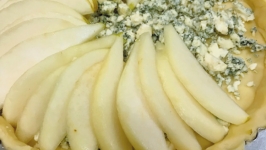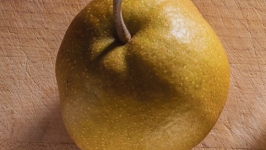Fall Fruit
Sweet and juicy, pears offer a lush bounty of benefits
As the season’s hues start shifting from green to gold, many begin looking forward to the enticing delights from the state’s abundant orchards. While apples are the mainstay of the fall fruit spotlight, pears are just as plentiful and offer an equal dose of nutrition. There are a few reasons you’ll find pears in the company of apples, and that’s because they have similar needs.
“Pears are an easy crop to grow with apples because they share similar pests and diseases, thus can be treated together,” says John Melick of Melick’s Town Farm in Califon. “However, they take longer to get established and require more space than apples.”
Melick explains that many apple varieties can be grown on dwarf rootstock, which means you can plant trees in higher densities and have greater yields.
“Pears cost more per pound than apples because of the extra space and time they need to grow,” he says. “There’s a saying—‘You plant pears for your heirs’—in that it’s a longer-term crop that can take six to eight years before you get consistent yields. Apples, on the other hand, only take about three to four years before they are at full production.”
There are many different varieties of pears, ranging from beautiful shades of gold to green, red and brown. Common varieties you’ll find growing in New Jersey are Bartlett, Red Bartlett, Clapp and Bosc.
Pears contain two vitamins you may not ordinarily expect. They are a good source of vitamin K, and also vitamin C.
“Clapps tend to be the earliest to ripen and can be ready as soon as late August. Boscs are hardy and can be picked in September and sold into October or longer when put into cold storage,” Melick says. But orchards have to be careful when storing. “Apples produce ethylene gas, which can ripen the pears quicker,” he says. “Commercial growers will often have separate refrigeration to deter this.”
Like peaches, pears are picked before they are completely ripe, so you have to pay attention in order to enjoy them at their peak of perfection.
Melick recommends storing pears in the refrigerator and taking them out to ripen gradually when you’re ready to enjoy them, keeping a careful eye if temperatures get warm, which can cause them to ripen quicker.
Aside from the shape and taste, a pear’s texture is particularly unique. “Pears are really high in fiber, which is indicated in their telltale sandpapery texture,” says Anthony Dissen, MA, RDN and Instructor of Health Science at Stockton University in Galloway.
“Most pears have about 4 to 5 grams of fiber, which is almost 10% of your daily value,” says Dissen, adding that pears contain two types of fiber, each of which have a different effect on the body.
“An average pear contains 45% of your daily value of insoluble fiber, and 55% of your daily value of soluble fiber,” he explains.
“Insoluble fiber resists change by the time it gets into the large intestine, which helps feed and grow the healthy bacteria,” he says.
“Soluble fiber is also good for digestion, as it slows it down, helping to stabilize blood sugar levels.”
Aside from texture, the color of a pear indicates additional benefits.
“Pears are rich in antioxidants, which primarily exist in their skin. The skin color of fruits and vegetables correspond to different types of antioxidants and phytochemicals,” says Dissen. “It’s better to leave the skin on to get these benefits. Furthermore, the skin helps the pear hold up in cooking and not turn to mush.”
Lastly, pears contain two vitamins you may not ordinarily expect.
“They are a good source of vitamin K, which many people may think of being only in dark, leafy greens,” he says. “However, one medium-sized pear contains roughly 7% of your daily value of vitamin K, which is essential to bone health and blood clotting.”
Pears are also a good source of vitamin C—a nutrient often associated exclusively with citrus fruits. “Vitamin C helps with the body’s ability to absorb iron. Sometimes, if someone has low iron, it may not necessarily mean they need to consume more of it— they just need to eat foods that help them absorb it better,” says Dissen, adding that oatmeal is a good iron-rich choice that goes well with pears.
So as orchards open for the season, savor the sweetness of pears, knowing that their nectar is brimming with nutrition that stems far beyond the tree.








